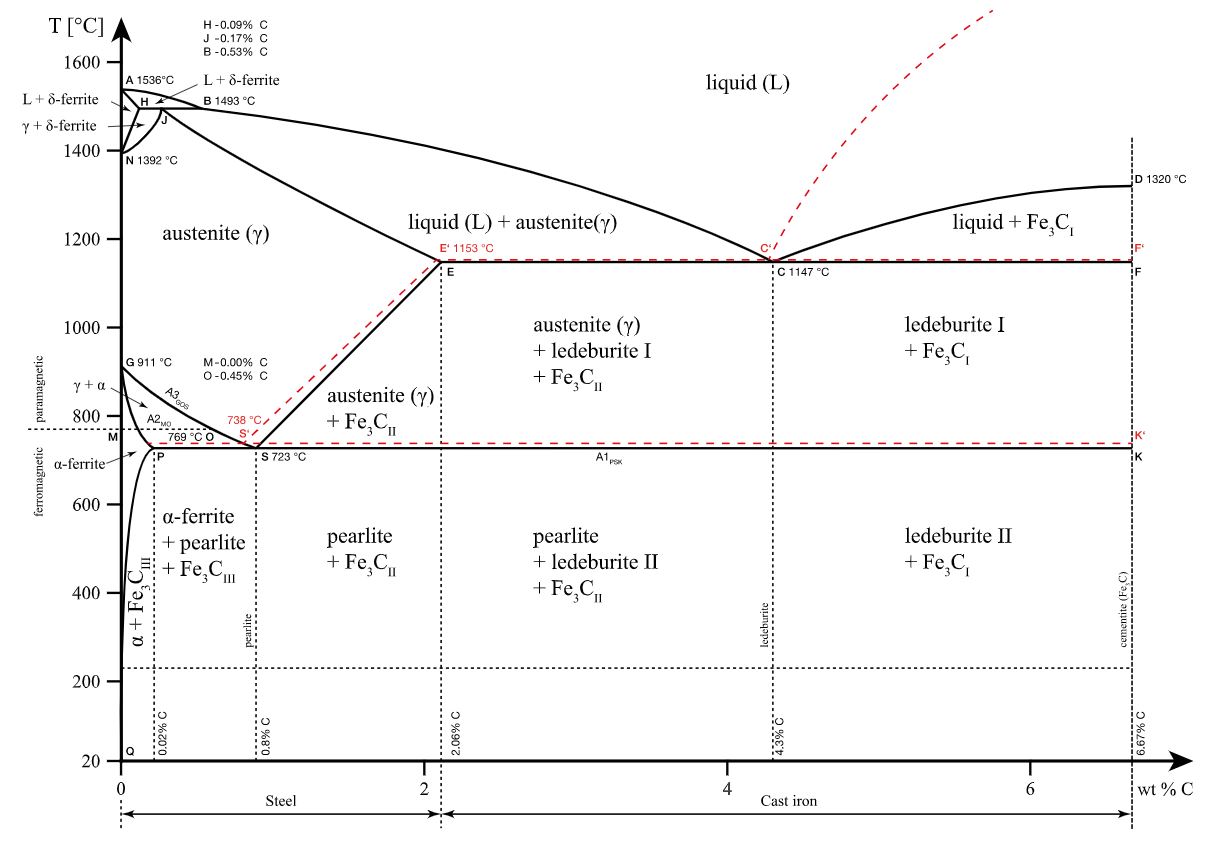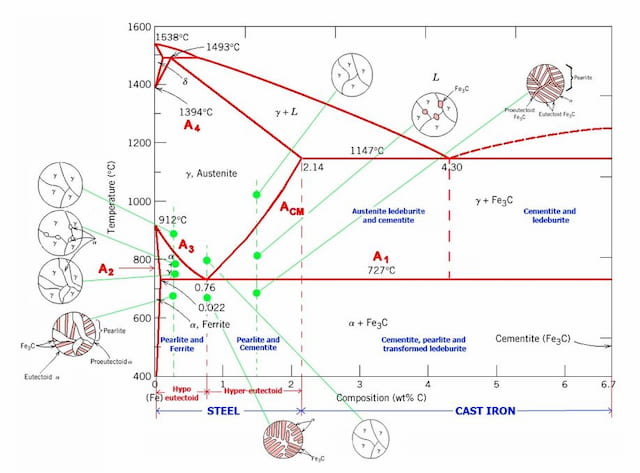Iron Iron Carbide Diagram
Different Phases
α-ferrite
Existing at low temperatures and low carbon content, α-ferrite is a solid solution of carbon in BCC Fe. This phase is stable at room temperature. In the graph, it can be seen as a sliver on the left edge with Y-axis on the left side and A2 on the right. This phase is magnetic below 768°C.
It has a maximum carbon content of 0.022 % and it will transform to γ-austenite at 912°C as shown in the graph.
γ-austenite
This phase is a solid solution of carbon in FCC Fe with a maximum solubility of 2.14% C. On further heating, it converts into BCC δ-ferrite at 1395°C. γ-austenite is unstable at temperatures below eutectic temperature (727°C) unless cooled rapidly. This phase is non-magnetic.
δ-ferrite
This phase has a similar structure as that of α-ferrite but exists only at high temperatures. The phase can be spotted at the top left corner in the graph. It has a melting point of 1538°C.
Fe3C or cementite
Cementite is a metastable phase of this alloy with a fixed composition of Fe3C. It decomposes extremely slowly at room temperature into iron and carbon (graphite).
This decomposition time is long and it will take much longer than the service life of the application at room temperature. Some other factors (high temperatures and the addition of certain alloying elements for instance) can affect this decomposition as they promote graphite formation.
Cementite is hard and brittle which makes it suitable for strengthening steels. Its mechanical properties are a function of its microstructure, which depends upon how it is mixed with ferrite.
Fe-C liquid solution
Marked on the diagram as ‘L’, it can be seen in the upper region in the diagram. As the name suggests, it is a liquid solution of carbon in iron. As we know that δ-ferrite melts at 1538°C, it is evident that the melting temperature of iron decreases with increasing carbon content.
Structures
Each phase’s atoms are arranged in a different way, and this arrangement is called the crystal structure. The properties, like strength or flexibility, will all depend on which structure category the phase falls into. Here’s a brief explanation of the five most common crystal structure types:
Body-centered cubic (BCC) crystal: This structure is like a cube with an atom in each corner and one slap bang in the middle. It’s strong but not very flexible, so materials with this type (like ferrite) tend to break easily, even though they’re most times hard.
Body-centered tetragonal (BCT): This is very similar to BCC, the only difference being that it’s stretched in only one direction—something that makes it very strong and hard. Not that you’ll be surprised, but martensite has a BCT structure.
Face-centered cubic (FCC) crystal: Just like with BCC, with FCC there is an atom at each corner of the cube, but this one has an extra one in the middle of each of the cube’s faces. Materials that fall into this category (like austenite) are flexible and ductile.
Lamellar: Materials that have this structure have thin alternating layers made from two materials: soft and ductile ferrite, and hard but brittle cementite.
Orthorhombic: This is a rigid and hard structure that we can describe kind of like a stretched cube with sides of all different lengths. Cementite is orthorhombic, which is why it’s both tough and brittle.
Reactions
There are two factors that have the biggest impact on determining what phase iron-carbon alloys are in—temperature and carbon content. This happens through different types of bonding, which we’ll describe below.
- Eutectoid: This happens when one solid phase separates out into two solid phases after cooling, and is known as the “eutectoid point” (you can see this on the diagram at 0.8%wt and 723 ℃). This point is where austenite turns into ferrite and cementite, too.
- Eutectic: Similarly, this one also transforms into two solids—but from a liquid, and at the melting point, hardening as it cools.
- Peritectic: Though it’s rare to see, this reaction happens when a molten and solid phase forms a second solid phase.




.jpeg)

Comments
Post a Comment